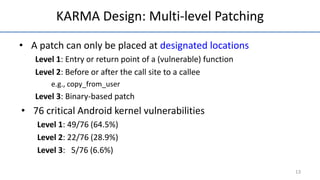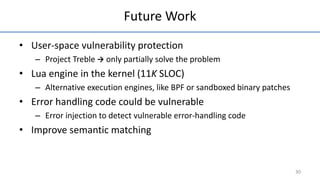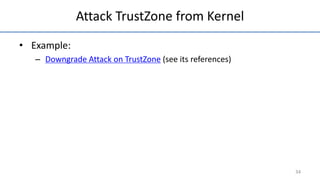KARMA: Adaptive Android Kernel Live Patching
- 1. Adaptive Android Kernel Live Patching Yue Chen1, Yulong Zhang2, Zhi Wang1, Liangzhao Xia2, Chenfu Bao2, Tao Wei2 Florida State University1 Baidu X-Lab2 USENIX Security Symposium 2017
- 2. Android Kernel Vulnerabilities 2 Apps Java API Framework Native C/C++ Libraries Linux Kernel Android Runtime Hardware Abstraction Layer TrustZone
- 3. Android Kernel Vulnerabilities 2 Apps Java API Framework Native C/C++ Libraries Linux Kernel Android Runtime Hardware Abstraction Layer TrustZone
- 4. Android Kernel Vulnerabilities 2 Apps Java API Framework Native C/C++ Libraries Linux Kernel Android Runtime Hardware Abstraction Layer TrustZone
- 5. Number of Disclosed Android Kernel Vulnerabilities 3
- 6. Problem: Old Exploits Remain Effective Number of devices vulnerable to two root exploits as of Nov. 2016 4 • Android 5.0 released in November 2014 • 46.3% of devices run an older version in September 2016
- 7. Challenges • Officially patching an Android device is a long process Third-party • Delayed/non-existing kernel source code Binary-based 5
- 8. Challenges • Severely fragmented Android ecosystem Adaptive 6 http://d.ibtimes.co.uk/en/full/1395443/android-fragmentation-2014.png
- 9. Solution Third-party Binary-based Adaptive Kernel Live Patching 7 Key requirements: • Adaptiveness – It should be adaptive to various device kernels • Safety – Patches should be easy to audit – Their behaviors must be technically confined • Timeliness – Response time should be short, after disclosed vulnerability or exploit • Performance – The solution should not incur non-trivial performance overhead
- 10. Feasibility Study: Dataset • Studied 1139 Android kernels 8
- 11. • Most kernel functions are stable across devices and Android releases • Most vulnerabilities triggered by malicious inputs • Many functions return error codes – Return a pointer ERR_PTR Feasibility Study: Observations 9
- 12. • Most kernel functions are stable across devices and Android releases • Most vulnerabilities triggered by malicious inputs • Many functions return error codes – Return a pointer ERR_PTR Gracefully return Feasibility Study: Observations 9 Filter them
- 13. Overall Approach: Input Validation 10
- 14. KARMA KARMA: Kernel Adaptive Repair for Many Androids Adaptive – Automatically adapt to various device kernels Memory-safe – Protect kernel from malicious (misused) patches Multi-level – Flexible for different vulnerabilities 11
- 15. KARMA Design: Safety • Patches are written in Lua, confined by Lua VM at runtime • A patch can only be placed at designated locations • Patched functions must return error codes or void – Use existing error handling to recover from attacks • A patch can read but not write the kernel memory – Confined by KARMA APIs – Prevent malicious (misused) patches from changing the kernel – Prevent information leakage 12
- 16. KARMA Design: Multi-level Patching • A patch can only be placed at designated locations Level 1: Entry or return point of a (vulnerable) function Level 2: Before or after the call site to a callee e.g., copy_from_user Level 3: Binary-based patch • 76 critical Android kernel vulnerabilities Level 1: 49/76 (64.5%) Level 2: 22/76 (28.9%) Level 3: 5/76 (6.6%) 13
- 17. KARMA Patch Example Part of the official patch of CVE-2014-3153 (Towelroot) 14
- 18. KARMA Patch Example 15 -EINVAL More complex examples in the paper
- 19. KARMA API 16
- 20. KARMA API Available to patches 16
- 21. KARMA Architecture 17 Offline Patch Generation and Verification Online Live Patching by KARMA Client
- 22. Offline Patch Adaptation Patch A 18
- 23. Offline Patch Adaptation Three steps: 1. Identify the vulnerable functions in the target kernel – Same function but different names – Inlined 2. Check if the reference patch works for the target kernel – Same function but different semantics 3. Adapt the reference patch for the target kernel 19
- 24. Vulnerable Function Identification Example CVE-2015-3636 (PingPong Root) Device A: ping_unhash Device B: ping_v4_unhash Func_A Func_B Func_C Func_D Func_E ping_unhash Func_A Func_B Func_C Func_D Func_E ping_v4_unhash 20 Call graph based similarity comparison
- 25. Semantic Matching • Check if two functions are semantically equivalent • If so, adapt the reference patch to the target kernel • Syntactic matching is too strict – Different compilers can generate different code with same semantics • Instruction order, register allocation, instruction selection, code layout 21
- 26. Semantic Matching Same semantics with different syntax 22
- 27. Semantic Matching Same semantics with different syntax 22
- 28. Semantic Matching Same semantics with different syntax 22
- 29. Semantic Matching Same semantics with different syntax 22
- 30. Semantic Matching Same semantics with different syntax 22
- 31. Semantic Matching • Check if two functions are semantically equivalent • If so, adapt the reference patch to the target kernel • Syntactic matching is too strict – Different compilers can generate different code with same semantics • Instruction order, register allocation, instruction selection, code layout • Use symbolic execution to abstract these differences and adapt patches – Use approximation to improve scalability (details in the paper) 23
- 32. Online Patch Application 24 Function entry point hooking
- 33. Prototype Implementation • Lua engine in kernel (11K SLOC) – Simple – Memory-safe – Easy to embed and extend – 24 years of development • Semantic matching – angr 25
- 34. Evaluation: Applicability • Evaluated 76 critical vulnerabilities in the last three years • Patch level: – Level-1: 49 – Level-2: 22 – Level-3: 5 26
- 36. Evaluation: Adaptability Types and frequencies of instruction opcodes 27
- 37. Evaluation: Adaptability Number of function calls and conditional branches (to abstract CFG) 27
- 38. Evaluation: Adaptability KARMA’s semantic matching 27
- 39. Evaluation: Performance CF-Bench results with different patches 28
- 40. Evaluation: Performance Execution time of chmod with different patches 29
- 41. Future Work • User-space vulnerability protection – Project Treble only partially solve the problem • Lua engine in the kernel (11K SLOC) – Alternative execution engines, like BPF or sandboxed binary patches • Error handling code could be vulnerable – Error injection to detect vulnerable error-handling code • Improve semantic matching 30
- 42. Adaptive Android Kernel Live Patching www.YueChen.me Q & A
- 43. Backup Slides
- 44. Attack TrustZone from Kernel • Example: – Downgrade Attack on TrustZone (see its references) 34
- 45. Observations • Most kernel functions are stable across devices and Android releases. Number of syntax clusters for each function 35 About 40% of the shared functions have only one cluster, and about 80% of them have 4 clusters or less. Cluster Number Kernel Function Number
- 46. Observations • Most kernel functions are stable across devices and Android releases. 36 For about 60% of shared functions, the largest cluster contains more than 80% of all the kernels that have this function. Kernel Function Number Percentage of kernels in the largest cluster for each function
- 47. Symbolic Execution • Challenges – Avoid path explosion – Impact to the environment • Practical Solution – Non-local memory writes – Function calls (and their arguments) – Function return values • Adaptation (e.g., mutate constants or offsets) – foo(symbol_A + 4, 36) foo(symbol_A + 8, 36) 37
- 48. Evaluation: Overall Performance • Complex patch for most frequent syscall (gettimeofday) during web browsing • Overall system performance overhead in this extreme situation: 0.9% 39
- 55. You May Also Like • A time machine to locate vulnerabilities: – Pinpointing Vulnerabilities • Protect your computer by encrypting memory all the time: – Secure In-Cache Execution • Fine-grained dynamic ASLR during runtime: – Remix: On-demand Live Randomization 55























































